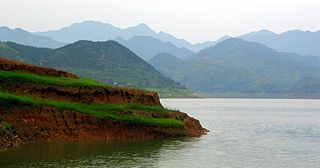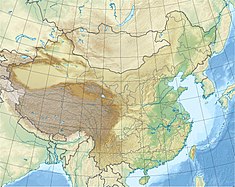
The Xiluodu Dam is an arch dam on the Jinsha River, i.e. the upper course of the Yangtze in China. It is located near the town of Xiluodu in Yongshan County of Yunnan Province but the dam straddles into Leibo County of Sichuan Province on the opposite side of the river. The primary purpose of the dam is hydroelectric power generation and its power station has an installed capacity of 13,860 MW. Additionally, the dam provides for flood control, silt control and its regulated water releases are intended to improve navigation downstream. Construction on the dam and power station began in 2005 and the first generator was commissioned in 2013, the last in 2014. It is operated by China Yangtze Power and is currently the fourth-largest power station in the world, as well as the fifth tallest dam world-wide.
The Xiangjiaba Dam is a large gravity dam on the Jinsha River, a tributary of the Yangtze River in Yunnan Province and Sichuan Province in southwest China. The facility has eleven Francis turbines, four with a capacity of 812 MW and four rated at 800 MW and three with 450 MW, totalling an installed capacity of 7,750 MW. Xiangjiaba Dam is China's fourth-biggest hydropower station following Three Gorges Dam, Baihetan Dam and Xiluodu Dam. Construction started on November 26, 2006, and its first generator was commissioned in October 2012. The last generator was commissioned on July 9, 2014.
The Guandi Dam is a gravity dam on the Yalong River, a tributary of the Yangtze River in Sichuan Province Southwest of China. It supplies water to four hydroelectric generators, each with generating capacity of 600 MW. The total generating capacity of the project is 2,400 MW. Construction started on October 20, 2010, with a ground-breaking ceremony. On February 9, 2012, the dam began to impound the reservoir and the last of the four generators were commissioned on 28 March 2013.

The Shuangjiangkou Dam, also referred to as Shuang Jiang Kou, is an embankment dam currently being constructed in a gorge on the Dadu River in Sichuan Province, China. When completed, the 312 m-tall (1,024 ft) dam will be the tallest dam in the world. Preliminary construction began in 2008 and the entire project was expected to be complete in 2018. By April 2011, over 200,000,000 m3 (261,590,124 cu yd) of material had been excavated from the construction site. In March 2013, China's Ministry of Environmental Protection approved construction on the dam's superstructure and associated facilities. The government acknowledged that the dam would have negative impacts on the environment but that developers were working to mitigate them. The dam is being built by the Guodian Group at a cost of US$4.02 billion. The entire construction period is expected to last 10 years. All turbines are expected to be commissioned by 2023.
The Dagangshan Dam is an arch dam on the Dadu River in Shimian County, Ya'an, Sichuan Province, China. The dam houses a hydroelectric power station with 4 x 650 MW generators for a total installed capacity of 2,600 MW. Construction on the dam began in 2008 and the power plant in 2010. The first two generators were commissioned on 2 September 2015, and the entire project was completed in 2016.

The Guanyinyan Dam is a gravity dam on the Jinsha River 30 km (19 mi) southwest of Panzhihua on the border of Yunnan and Sichuan Provinces in China. The purpose of the dam is hydroelectric power generation and flood control. Construction on the dam started in 2008 and the river was diverted by 2010. The first generator was operational on 20 December 2014 and the fourth on 14 December 2015. The entire power station should be operational by 2016. When complete, the dam will support a 3,000 MW power station consisting of five 600 MW Francis turbine generators.
The Liyuan Dam is a concrete-face rock-fill dam on the Jinsha River on the border of Yulong County and Shangri-La County, Yunnan Province, China. The dam has an associated hydroelectric power station with a 2,400 MW power station containing 4 x 600 MW generators. Construction on the river diversion for the dam began in 2008. It began to impound its reservoir in November 2014 and on December 28, 2014 the first generator was commissioned. The second generator was commissioned in July 2015.
The Silin Dam is a concrete gravity dam on the Wu River in Sinan County, Guizhou Province, China. The dam has an associated hydroelectric power plant with a 1,080 MW capacity utilizing 4 x 270 MW Francis turbine-generators. The dam is 310 m (1,017 ft) long, 117 m (384 ft) high and composed of roller-compacted concrete. Its reservoir has a 1,205,000,000 m3 (976,909 acre⋅ft) capacity, 184,000,000 m3 (149,171 acre⋅ft) of which is flood storage. The dam also supports ship lift. Construction on the dam began in October 2004, the dam began to impound the river in March 2008 and by May 2009, the power plant's first generator was operational. The remaining generators were operational by December 2009.
The Lianghekou Dam is a concrete-face rock-fill dam currently under construction on the Yalong River in Yajiang County, Sichuan Province, China. The dam is located at the confluence of the Yalong, Xianshui and Qingda Rivers. The 295 m (968 ft) tall dam is the highest embankment dam in the country and support a 3,000 MW power station. Studies for the dam were completed between 2005 and 2009 with preliminary construction beginning that year. Major works on the dam officially began in October 2014. The first two generators were commissioned in September 2021 and the final unit was put in service in March 2022.
The Longkaikou Dam is a gravity dam on the Jinsha River in Dali Bai Autonomous Prefecture, Yunnan province, China. The dam has a height of 119 m (390 ft) and was constructed with roller-compacted concrete. Construction on the dam began in 2007, the river was diverted in January 2009 but construction was briefly halted in June 2009 by the Ministry of Environmental Protection after it was being constructed without approval. On 25 November 2012 the reservoir was impounded and the first of five 360 MW Francis turbine-generators was commissioned on 21 May 2013. The last was commissioned on 29 November 2013. The dam was expected to displace 2,000 people. The dam also supports a fish proliferation system.
The Jinping-I Dam also known as the Jinping-I Hydropower Station or Jinping 1st Cascade, is a tall arch dam on the Jinping Bend of the Yalong River in Liangshan, Sichuan, China. Construction on the project began in 2005 and was completed in 2014. Its power station has a 3,600 MW capacity to produce between 16 and 18 TW·h annually. Supplying the power station is a reservoir created by the 305-meter-tall arch dam, the tallest in the world. The project's objective is to supply energy for expanding industrialization and urbanization, improve flood protection, and prevent erosion.
The Jinping-II Dam, also known as the Jinping-II Hydropower Station, is a gravity dam on the Jinping Bend of the Yalong River in Sichuan, China. Construction on the project began in 2007 and it was complete in 2014. Its hydroelectric power station has a 4,800 MW installed capacity.

The Baozhusi Dam is a gravity dam on the Bailong River, located 23 km (14 mi) northwest of Guangyuan in Sichuan Province, China. Construction on the dam began in 1984, the generators were operational between 1996 and 1998 while the rest of the facilities were complete 2000. The dam was constructed for hydroelectric power generation, flood control and water supply for irrigation and industrial uses. The 132 m (433 ft) tall concrete gravity dam creates a 2,550,000,000 m3 (2,067,319 acre⋅ft) reservoir with a surface area of 61.2 km2 (24 sq mi). On either side of power station at the dam's base, there are two gate-controlled chute spillways. Beside them are two pairs of intermediate sluice-controlled orifice openings. Below the left intermediate opening are two bottom sluices. The total discharge capacity of the spillways and openings is 16,060 m3/s (567,154 cu ft/s). The dam's power station contains 4 x 175 MW Francis turbine-generators which are afford a maximum hydraulic head of 103 m (338 ft) given the dam's height.
The Kajiwa Dam is a concrete-face rock-fill dam on the Muli River near Kajiwa in Muli Tibetan Autonomous County, Sichuan Province, China.
The Lizhou Dam is a run-of-the-river hydroelectric arch dam on the Muli River in Muli Tibetan Autonomous County, Sichuan Province, China.
The Maoergai Dam is a rock-filled embankment dam on the Heishui River in Mao County of Sichuan Province, China. The primary purpose of the dam is hydroelectric power production and it supports a 420 MW power station. Preliminary construction for the dam began in 2006 while construction on the dam and power station commenced in 2008. The generators were commissioned in 2011. To produce power, water from the reservoir is diverted to a power station downstream through a 16.15 km (10.04 mi) long headrace tunnel and penstock. The difference in elevation between the reservoir and power station affords a hydraulic head of 168 m (551 ft). The dam sits just below the headwaters of the Heishui and water discharged through its power station regulates the flow of water for smaller power stations downstream.
The Pangduo Hydro Power Station is a reservoir and dam on the Lhasa River in Lhünzhub County to the east of Lhasa, Tibet Autonomous Region, China. The primary purposes are hydroelectric power generation and agricultural irrigation. Work started in 2008. The first turbine came into production in 2013 and the other three turbines in 2014. With annual generation capacity of 599 million kilowatt hours, it has been called the "Tibetan Three Gorges". Nevertheless, the comparison is hyperbole since the dam is only able to impound less than 1/30th that of Three Gorges.(31.9 vs 0.97 million acre-feet).




